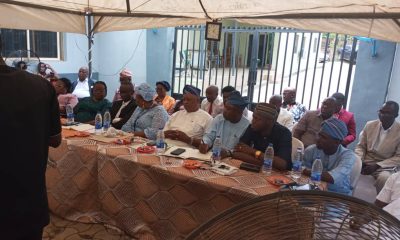Opinion
Left To rot: The Pathetic Story Of OSSADEP

Anytime Akeem Oladehinde pass through the headquarters of Osun State Agriculture Development Programme (OSSADEP), he is captivated by the sight of a gigantic structure that tells the pathetic story of a beautiful initiative going bad every minutes. Oladehinde, who is in his early 40s, is always disturbed that the project which hold so much promises in the beginning is almost fizzling out, and wonder what really went wrong.
But he isn’t alone with that feeling. This is because OSSADEP is deteriorating rapidly, but only few could notice, or let me say, pay attention to the systematic collapse of a hitherto well celebrated project. Take a walk through the large expanse of land that is occupying the headquarters on the outskirt of Iwo in Osun state, and all you will most certainly see is a distasteful sight of a great project on the abyss of total ruins.
“It’s disturbing, frankly, what has become of OSSADEP, and that it is unfolding right before our eyes makes it even more sad,” Oladehinde, who is a trained public administrator noted, adding that “watching a promising project deteriorated this bad is something so hard to bear.”
For any discerning observers, it would be hard not to understand the disappointment of Mr Oladehinde on the dwindling fortune of OSSADEP. But the question that easily comes to minds is, what actually went wrong? How did a project that promised so much in the start to have receded so drastically that it is on the verge of total collapse.
To better answer that, we’ll need to look back and see where things actually went wrong, and caused OSSADEP to lose substantial value and relatively low impact to host community. The when, what, why, how, who and where are critical in understanding the prevailing circumstances of the government project.
When Osun state was carved out from Oyo state in 1991, a lot of changes was taken to reflect the new reality. And that brought about the creation of OSSADEP in 1992 with headquarters situated in Iwo, Osun state. That threw host community into wild excitement on the prospect that the project would boost food security and benefit them positively.
OSSADEP was critical to Osun state and host community not just because it will contribute to food security and economic gains, but its role also entail training and putting rural roads in good condition to ease transportation of goods and persons. Before things take a wrong turn, at least, OSSADEP has 1000 people on its employment.
Talking about the start, a retired personnel at OSSADEP, shared some insights on the promises that heralded the project in Osun. Mr. Awo, who went down memory lane, recalled that he was moved to OSSADEP like most of his colleagues in 1992 from the Oyo North Agriculture Development Project (ONADEP).
“I joined ONADEP in 1984 and was there in Saki, Oyo state, until 1992 when most of us that are from Osun state were moved to OSSADEP since we’re no longer under Oyo state,” he noted. But 28 years after, the promises that heralded them when the project began is fast losing steam, and his simple response to that was leadership failure.
Pointing out that the objectives of OSSADEP was “to contribute to improvement of national food security through increasing food production on an economically and environmentally sustaining manner”, the senior citizen said things began to go bad when leadership failures and government indifference characterised the project. While he noted that things sound promising in the beginning, the point when OSSADEP started to drift was after the pioneer Project Manager, Mr. J. O And left the project.
“When we left ONADEP and set for OSSADEP, Mr. J. O Abey, an Ijesa man, who incidentally was the project manager there, led every Osun indigenes to the new set up and continue his role,” he noted, adding that OSSADEP had no issue whatsoever at the start because they came with about 10 tractors and neatly hundred vehicle of various kind to support operations.
Another ex-employee of OSSADEP who corroborated the account of Mr Awo noted that OSSADEP began to nosedive after Mr Abe retired and some properties belonging to the project were put up for sale in a controversial manner without no replacements. According to the source who doesn’t want his name to be quoted, tractors and vehicles belonging to OSSADEP were sold and some even given out as a gift, to the extent that a military governor in the state at that point was gifted two vehicles.
“As if Mr Abe read into the future because when he was leaving the PM position, he admonished those coming after him to ensure they sustain everything in OSSADEP as government may not look the side of the initiative on the long run,” the source who choose anonymity said. “But that advice was brazenly ignored and immediately he left, the man that took over from him went on selling spree and what we staffs heard then was that the military governor at that time was gifted two vehicles.”
But things got even worse for OSSADEP when Bisi Akande as governor implemented a policy that cut the staff strength in headquarters and the three administrative zones– Iwo, Osogbo and Ife-Ijesa– to 350 in total. “Akande said he does want the total number of staff in OSSADEP to be more than 350, and that hugely impacted human resources capital in the organization, which also contributed to the challenges playing out today.”
Successive governors make no serious effort to change things for the better, and irregular salaries that characterised the administration of Governor Rauf Aregbesola that compounded the woes of OSSADEP. More broadly, OSSADEP’s loss of fortunes encapsulates a long-brewing debate in Osun over whether government is sincere about most of their pronouncement on agriculture development. After all, the pathetic story of OSSADEP says a lot.
-

 News4 days ago
News4 days agoAPC National Chairman: Moves To Oust Ganduje Put Presidency In Quandary
-

 News3 days ago
News3 days agoOsun RAAMP Opens Bid For Road Constructions Statewide
-

 News5 days ago
News5 days agoComrade Joseph Sangosanya dies at 67
-

 Opinion3 days ago
Opinion3 days agoRegulatory Commission Must Wakeup From Slumber To Rescue EKEDC From The Shackles Of Dere Otubu By ADAPHAI



